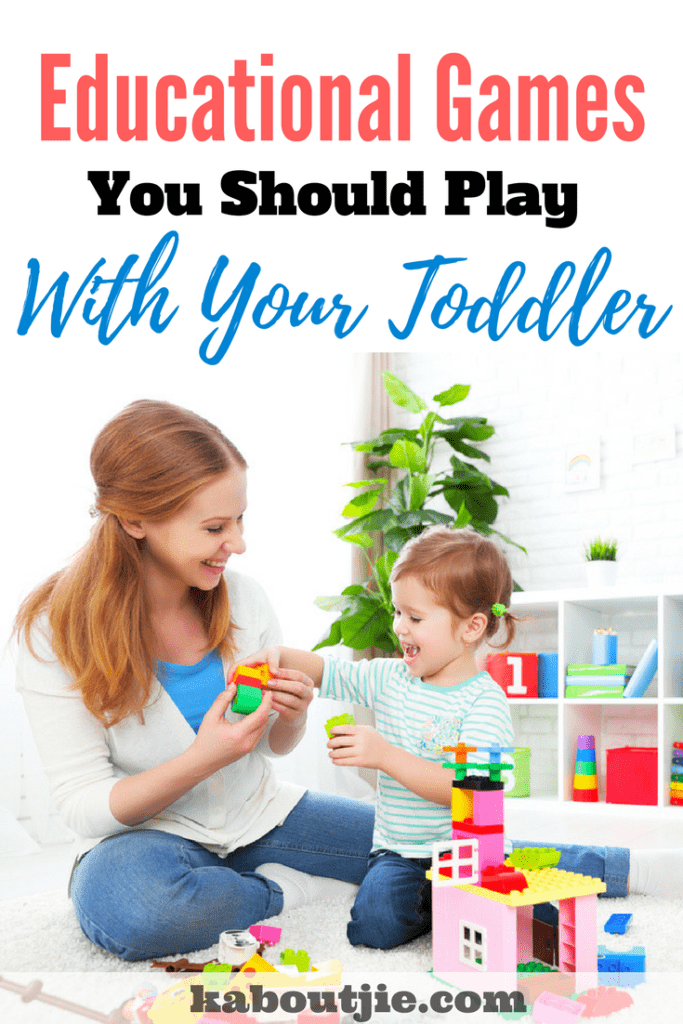Your toddler is not only growing physically but also mentally. He or she is starting to discover the world around and you, as a parent, should be there to help the little one enhance his/her cognitive powers. Development psychology teaches us that at this early stage in life children learn from doing and play is one of the most important means for them to gain knowledge and skills, together with developing a strong emotional bond with the parent.
Such skills include observation, interaction, motor abilities, problem-solving, vocabulary, and so on. Since fun, games, and toys are your best allies in helping your child make sense of the world, let’s see some of the best and most engaging educational games parents should play with their toddlers.
You should introduce these games and activities progressively in the child’s schedule and do not pressure the little one into doing something that he/she does not like.

1. The Alphabet Song
Exposing your child to the alphabet, letters, sound of letters, and a fun way to mix letters with music is one of the simplest ways to help the little one boost his cognitive skills. At an early stage, you can begin to sing the Alphabet song. Then, you can start showing the letters in association with the names and images of animals or play alphabet-based puzzles.
Singing letters and words and singing songs helps your child build better memory skills, word recognition, and literacy. You can start with the alphabet song and go on from there. It is of extreme importance that you read to your child daily and create an environment where reading becomes a natural, fun activity.
2. The Cereal String
Treading circle-shaped cereals on a piece of string is a fun game, which develops the child’s counting skills. All you need is a bowl of O shaped cereal (without much sugar, as many will turn into snacks) and a solid piece of string. Stay together with the child and show him how to thread the cereals onto the thread. At a very early age, your goal is to help the child develop fine motor skills.
However, this game is excellent to introduce counting. According to pediatrics and psychology specialists, children can understand and develop basic number skills in their first year of life. It is a great activity to teach your child to count and understand basic arithmetic operations.

3. Coloring Book
You need to have some patience with this one, as children this age do not have enough motor skills to keep the coloring within the guiding lines. They also do not correctly associate colors with elements, in reality, so you will have to deal with some pink giraffes for a while. However, coloring books have tremendous cognitive benefits for children (and for adults as well). Progressively, children will gain motor skills, attention skills, spatial awareness, perspective, words, and many more.
4. Blocks Play
Playing with blocks is an excellent way to help your child gain plenty of cognitive skills. Firstly, blocks help children with their counting skills and, of course, with their basic arithmetic skills. Counting blocks are the first step, as blocks play promote motor learning, spatial awareness and cause and effect associations. You can use blocks to introduce the concept of measure as well: “how many blocks tall are you?” is one approach; another one is measuring other objects with the help of blocks.
5. Hide-and-Seek with Objects
Hide-and-seek is a nice and fun way to develop problem-solving skills in very young children. You can show the child an object, prompt him to pay attention to the direction you will take, then go in another part of the room, and hide it. Your child will need to use his attention skills to figure out the general area where you hid the object. Moreover, he will have to factor in the size, shape, type of object you hid to narrow down the possibilities of it being in one specific place. Through deduction, he will seek and find the object.
Another form of hide-and-seek is for the parent to prompt the child to hide the object – as the parent needs to find it. This form of play also teaches the child to memorize and follow the rules and make a cognitive effort into finding the best places of hiding.
6. Obstacle Play
Creating mini obstacles (safe ones) for the child around the house will determine the little one to find creative ways of overcoming them. You can start with harmless physical obstacles around the room to teach the child to find other ways to get things done. Going around, over, under or through obstacles to achieve their goals helps children become more and more creative about space, their physical abilities, motor skills, and cause and effect relationships. As the child develops, so should the obstacles.
7. The Fun Clock
A large clock is a very nice way to introduce numbers and the concept of time to your child. You will need a colorful and amusing clock to keep the child interested. You can start with number learning and progressively promote the measurement of time. Let the child move the clock hands and learn which hand shows what time, verbalize the correct telling of time, play with the numbers, and accompany your time learning activity with rhymes, songs, and gestures.

8. Lego
While Lego pieces can be dangerous for very small children, you can use a few large blocks to promote spatial intelligence, counting, problem-solving, and deductive thinking. You can start by engaging a child in building a simple structure and ask questions such as “what goes here?” or “why do you think this goes with this?” Asking questions while building things is a powerful way to teach children problem-solving and decision-making.
They first have to think about the question, search their memory for the knowledge they have, bind the pieces of knowledge together, and come up with an answer or a solution. In adulthood, we take such matters for granted, but seeing a child engaged in mental processing at such an early stage is a small miracle in and out of itself.
A Little Warning for Parents
Children can get a formal and informal education every day because learning opportunities are everywhere. While the play is the easiest and most effective tool to help your child develop cognitive skills, some parents take some things too far and push children into achieving goals that are beyond their age and their mental abilities. Emotional connectedness and stability, bonding, attachments, safety, love, and assertiveness are as important as cognitive skills.
Shaping a child into becoming an overachiever with low frustration tolerance because the parents push, ask too much, and even use forms of punishment and negative reinforcement for poor performances do not lead to having a healthy child. Positive reinforcements for achievement and downtime in between activities – no matter how fun they are – take a child a very long way ahead to success.
 About The Author
About The Author
Jennifer Clarke is a financial advisor who has been in the health care industry for nearly 4 years. When she’s not working with numbers, she’s writing on her personal project, HealthCareSalariesGuide, a blog-type website that aims to give accurate depictions of the health care environment.
 Kaboutjie SA Mommy Blogs by Lynne Huysamen
Kaboutjie SA Mommy Blogs by Lynne Huysamen





That is so true. Some parents forget that it is a child they’re dealing with and often forget that pushing a child too far can have an affect on their self-esteem and have a negative result instead of a positive result in what you’re trying to achieve.
My little boy is starting to learn words and shapes and even colors at the moment. I keep repeating the same words and phrases to help him remember. And surprisingly at his age he does pick up certain words and phrases very quickly and remember them.
He has colored blocks as well as wooden blocks with numbers, alphabet and pictures of objects and animals on them.
I bought him some coloring pens and a blank page book so that he can start drawing. He can’t really draw yet but he encourages me to draw objects and then he calls them by name which I think is a good thing. This is perfect bonding time and he always reacts positively when I ask him if we are going to draw.
I love the idea of cereal on a string and I know JD would really enjoy doing this. I will definitely put this on our to-do list.
The fun clock also sounds like a good idea.
JD is currently giving a go at all the obstacles that he can find. He climbed a rocky wall the other day before I could get to him. I was shocked but also impressed.
We have a set of steps without a rail that he could climb up but not down. Well, in the past week he has now mastered that skill as well.
He also climbed into the cooler box that is standing underneath the work station in the kitchen but couldn’t get himself out again and called for Mommy to assist. 😀
Thanks for this informative article with great tips!
These are excellent ideas, parents should always make the time to spend with their kids, and what better way than through play. It has been proven over time that kids learn their most through “play time”.
I am a huge fan of Lego’s, it keeps my son busy for lengthy periods and he feels so proud once he has achieved making a figurine/car etc. Lego’s allow kids to use their imagination on creating new and complex things which also boosts their confidence levels.
When it comes to bonding time with my little one we normally bake, even though he is a little boy, it doesn’t stop me from allowing him to help in the kitchen. After all the top chefs and bakers are male. 😊 he enjoys gardening and Checkers Hyper has this new awesome give away if you spend more than R150.00 you receive a seed and mini pot plant, we collected five thus far and enjoying it grow.
This is bonding time for us and learning experience in the same breath.
My husband and son normally experience more of the outside bonding and learning sessions, with fishing trips and camping. I do tag along but don’t really partake in the “tasks” they set out to achieve.
I love all the ideas. My 3 year old loves puzzles, coloring books , paint , making DIY play dough, making mud cakes in the garden